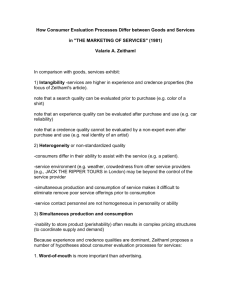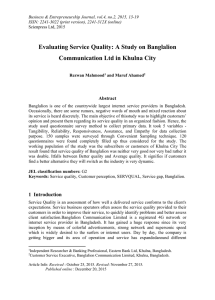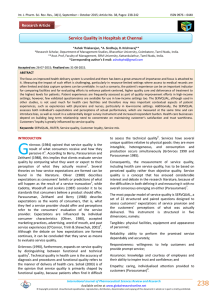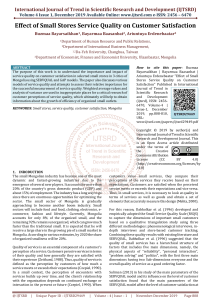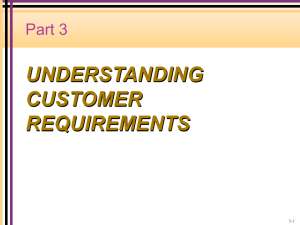Exploring the association between customers` perception of service
advertisement
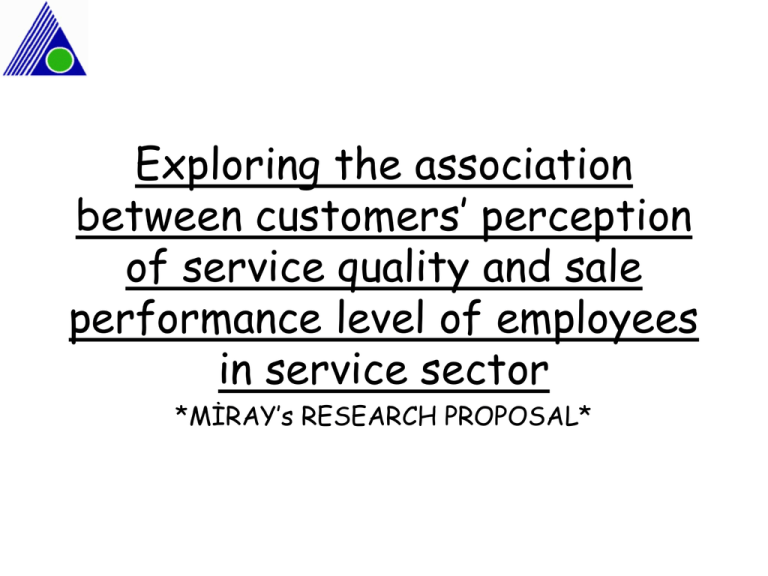
Exploring the association between customers’ perception of service quality and sale performance level of employees in service sector *MİRAY’s RESEARCH PROPOSAL* OBJECTIVE OF THE STUDY • The purpose of the study is to understand the underlying factors in connection to the customers’ perception of service quality and sale performance level of employees in health sector. OBJECTIVE OF THE STUDY 2 • Understanding the level of service quality (SERVQUAL) • Measurement of sale performance level • Measurement of customer satisfaction • Assessment of the relationship between level of SERVQUAL and customers’ satisfaction level Importance of the Study • As a result of highly competitive medium which surrounds today’s organizations, the importance of service quality has become a route in regard to reaching service excellence.The concepts of service quality, and that of customer satisfaction are of importance both in marketing theory as well as operational management. • Service quality has been understood as a form of attitude, and it implies an overall value judgment about the qualifications of both products and services provided by organizations (Parasuraman et.al. 1985, 1988; Zeithaml, 1988; Cronin & Taylor, 1992) RESEARCH Questions • • • Which service quality dimensions are related with the quality of sales performance level of employees? How do customers perceive the employees’ behaviors in purchasing process? Is there a difference between customers’ perceptions according to gender? Theoretical background • In today’s oversupplied world , where customers have very high demand, the service sector organizations are trying to become more customer-focused (Gonzales, Quesada, Picado and Eckalman, 2004). A customer-centered company has an external point of view, making plans and decisions based on the anticipated impact on the customer, and consequently, sale performance levels of employees play an important role in service sector. Theoretical background 2 • Service quality could be defined as the difference between customer expectations of service and perceived service. • If expectations are greater than performance, then perceived quality is less than satisfactory and hence customer dissatisfaction occurs. (Parasuraman et al., 1985; Lewis and Mitchell,1990). Theoretical background 3 • A number of studies have indicated a significant relationship between service quality and • Performance (Newman, 2001).As G Johnson, Tsiros and Lancioni(1995) and many others state • General systems theory is a research paradigm which seeks for the generalization of behavioral principles across a wide range of organizations regardless of economic sectors. Theoretical background 4 • In terms of the general systems theory there are two main approaches which are the interaction of subunits within a system and the interaction of the system with its environment. • This (contingency) theory explains the process of production starting from the provision of inputs from the environment, the transformation of raw materials into finished goods, and the distribution of products as the output of company. Theoretical background 5 • In the relevant literature there are numerous theoretical approaches to explain customer satisfaction, the most frequently preferred model based on the expectancy disconfirmation theory, which was developed by Richard Oliver (Kara, Lonial, Tarım and Zaim, 2005). • In accordance with this theory, disconfirmation is about the assessment of the difference between the consumer’s comparison of the service performance, and the consumer’s expectation. Theoretical background 6 • In Parasuraman’s words, SERVICE QUALITY is about “limited amount of switching and information gathering undertaken by consumers and the relatively high level of customer retention reflecting loyalty in behavior if not in service quality as perceived by the customer is the degree and direction of discrepancy between customer service perceptions and expectations” (1985). Key Concepts SQ1 • Dimensions of perceived service quality ( ServQual instrument) • These five dimensions constitute the skeleton of ServQual, probably the best-know, universal scale designed to measure the perceived service quality. These five dimensions are the result of a factor analysis applied to ten dimensions initially identified. • Tangibles : Appearance of physical facilities, equipment, personnel, and communication materials. • Reliability : Ability to perform the promised service dependably and accurately. Key Concepts SQ2 • Responsiveness : Willingness or readiness of employees to provide service. • Assurance : Knowledge and courtesy of employees and their ability to convey trust and confidence (competence, courtesy, credibility and security of the service ) • Empathy : Caring, individualized attention the firm provides its customers.( Having the customer’s best interest at heart). • Source: Grönroos, ‘Service Management & Marketing: A Customer Relationship Management Approach’ (2000) Key Concepts: Sales Performance • Sales performance is defined as evaluation of the behavior of the salesperson (i.e. the tasks consuming effort while working), since behavior contributes to the achievement of the organization’s objectives (Churchill et al.,1993) • The significance of the performance evaluation issue is underlined both by the need for information for effective control and the need for management to have some basis to facilitate decision making to improve salesperson performance and enhance sales organization effectiveness (Cravens,1995; Cravens et al,1993). Key Concepts: Customer Satisfaction • Customer satisfaction is viewed as a post-choice evaluative judgment of a specific purchase occasion (Hunt,1977; Oliver,1977,1980,1993). • Customer satisfaction has long been recognized in marketing thought and practice as a central concept as well as an important goal of business activities (Anderson et al.,1994a,b; Yi,1990). • Customer satisfaction is a result of a customer’s perception of the value received (Fornell et al,1996; Athanassopoulos, 2000). Methodology • The present study is a quantitative (numerical), and a cross-sectional one. • The research design is explanatory, and correlational in nature. • Sampling: Though the sampling procedure is not yet decided, most probably patients of a university hospital (Izmir) will be covered in this study. Methodology 2 Proposed Research Model Tangibility Reliability Assurance SERV QUAL Responsiveness Sales Performance Empathy Evaluations by Managers Self-Reporting Customer Satisfaction Methodology 3 • Research hypotheses: • H1) Conceptual dimensions of empathy and reliability are going to explain most of the variance in service quality. • H2) Conceptual dimensions of assurance, and reliability are going to explain most of the variance in customer satisfaction. Methodology 4 • Research hypotheses: • H3) Service quality is positively related to organizational performance. • H4) Higher the level of sales performance will be both higher the level of SERVQUAL and customer satisfaction. • H5) Customers’ perceptions of service quality is going to differ by gender. Methodology 5 Measurement instruments • 1) SERVQUAL:Servqual method is a technique that can be used for performing a gap analysis of an organizations service quality performance against customer service quality needs(Berry, Parasuraman and Zeithaml, 1995). • In this study, service quality will be measured by customer perceptions using servqual (Parasuraman et al.,1991), which contains 22 items belonging to tangibles (four items), reliability five items), responsiveness four items), assurance four items), and empathy (five items). This instrument is a 7 point Likert type questionnaire. Methodology 6 Measurement instruments (2) • 2)Self-Perf. Level: Prior research indicates that selfreport measures of performance are more appropriate for boundary spanning personnel Harris & Schaubroeck,1988) and do not suffer from an upward bias (Churchill et al.,1985). • A three-item scale capturing the respondents’ selfreported, long-term performances in the sales job is used. • Managers will be asked to rate their sales personnel force by using a single question ranging from 1 to 5 to determine level of sales performance. Methodology 7 • There are two different conceptualization of customer satisfaction as cumulative and transaction-specific which implies a post-choice evaluative judgment of a purchase occasion (Wang & Hing-Po Lo, 2002). • Customer satisfaction will be measured by using a 7-POİNT Likert type questionnaire consisted of three items developed by Kara,Lonial, Tarım & Zaim (2005). Limitations of The Study • The main limitation of this study is related with measurement methods. Although the assessment of SERVQUAL might be realized by learning both expectations and perceptions of customers, there are numerous different applications. This study aims at understanding the perceptions of customers only for ease of conducting the study. FIN • SUBMITTED by Miray Mollaoğlu • ADVISOR: • ASSOCIATE PROF. DR. Mehmet Y. YAHYAGİL • ************************************************************ • *THANKS FOR YOUR PATIENCE* • I’m ready for your questions and suggestions… November’07
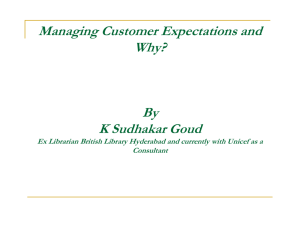
![[1] Parasuraman [2] [3] [1] [4] [5] [6] PZB SERVQUAL PZB 1985](http://s3.studylib.net/store/data/008892837_1-e5af2f024c1ef3de9a86bd868ba0295c-300x300.png)



